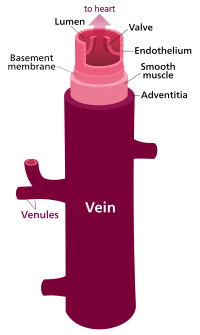
Photo from wikipedia
Significance The internal jugular veins are critical cerebral venous drainage pathways that are affected by right heart function. Cardiovascular disease and microgravity can alter central venous pressure (CVP) and venous… Click to show full abstract
Significance The internal jugular veins are critical cerebral venous drainage pathways that are affected by right heart function. Cardiovascular disease and microgravity can alter central venous pressure (CVP) and venous return, which may contribute to increased intracranial pressure and decreased cardiac output. Assessing jugular venous compliance may provide insight into cerebral drainage and right heart function, but monitoring changes in vessel volume is challenging. Aim We investigated the feasibility of quantifying jugular venous compliance from jugular venous attenuation (JVA), a non-contact optical measurement of blood volume, alongside CVP from antecubital vein cannulation. Approach CVP was progressively increased through a guided graded Valsalva maneuver, increasing mouth pressure by 2 mmHg every 2 s until a maximum expiratory pressure of 20 mmHg. JVA was extracted from a 1 cm segment between the clavicle and mid-neck. Contralateral internal jugular vein cross-sectional area (CSA) was measured with ultrasound to validate changes in vessel size. Compliance was calculated using both JVA and CSA between four-beat averages over the duration of the maneuver. Results JVA and CSA were strongly correlated (median, interquartile range) over the Valsalva maneuver across participants (r=0.986, [0.983, 0.987]). CVP more than doubled on average between baseline and peak strain (10.7 ± 4.4 vs 25.8 ± 5.4 cmH2O; p<.01). JVA and CSA increased non-linearly with CVP, and both JVA- and CSA-derived compliance decreased progressively from baseline to peak strain (49% and 56% median reduction, respectively), with no significant difference in compliance reduction between the two measures (Z=–1.24, p=.21). Pressure-volume curves showed a logarithmic relationship in both CSA and JVA. Conclusions Optical jugular vein assessment may provide new ways to assess jugular distention and cardiac function.
Journal Title: Journal of Biomedical Optics
Year Published: 2022
Link to full text (if available)
Share on Social Media: Sign Up to like & get
recommendations!